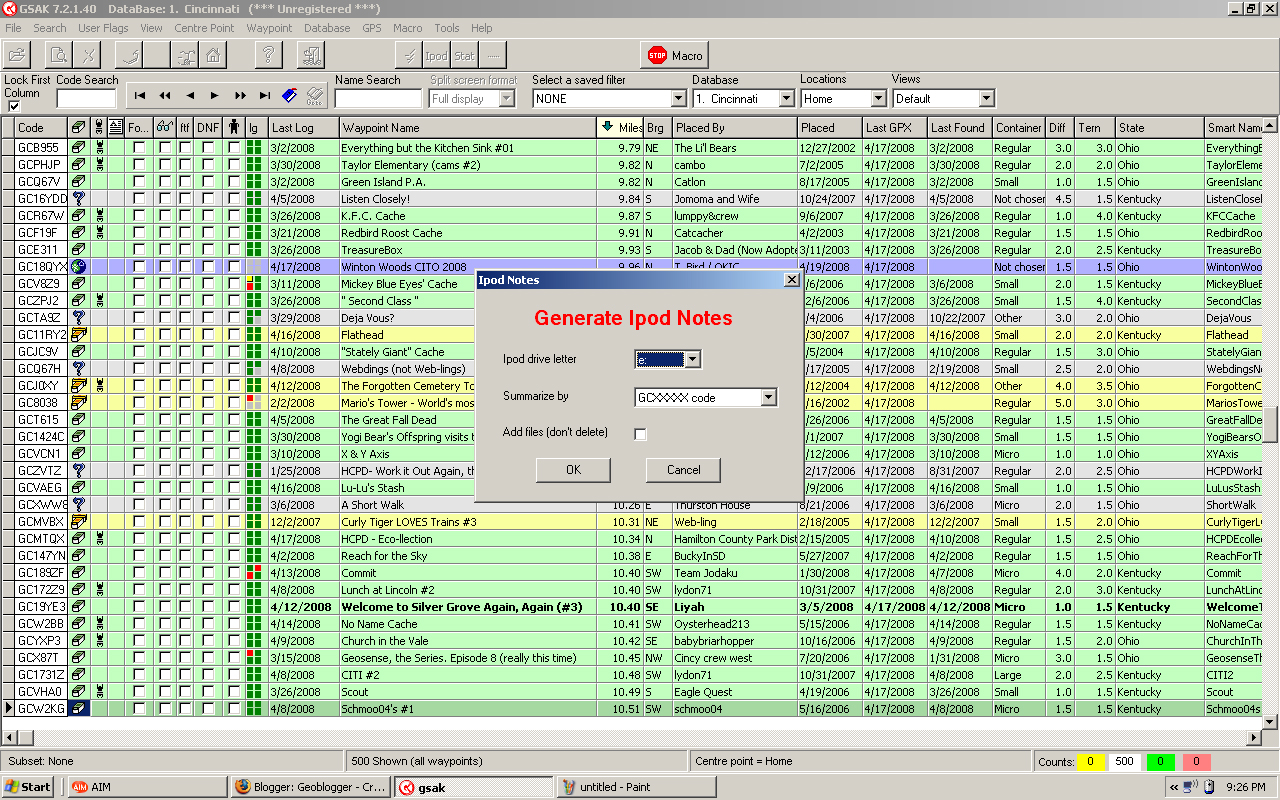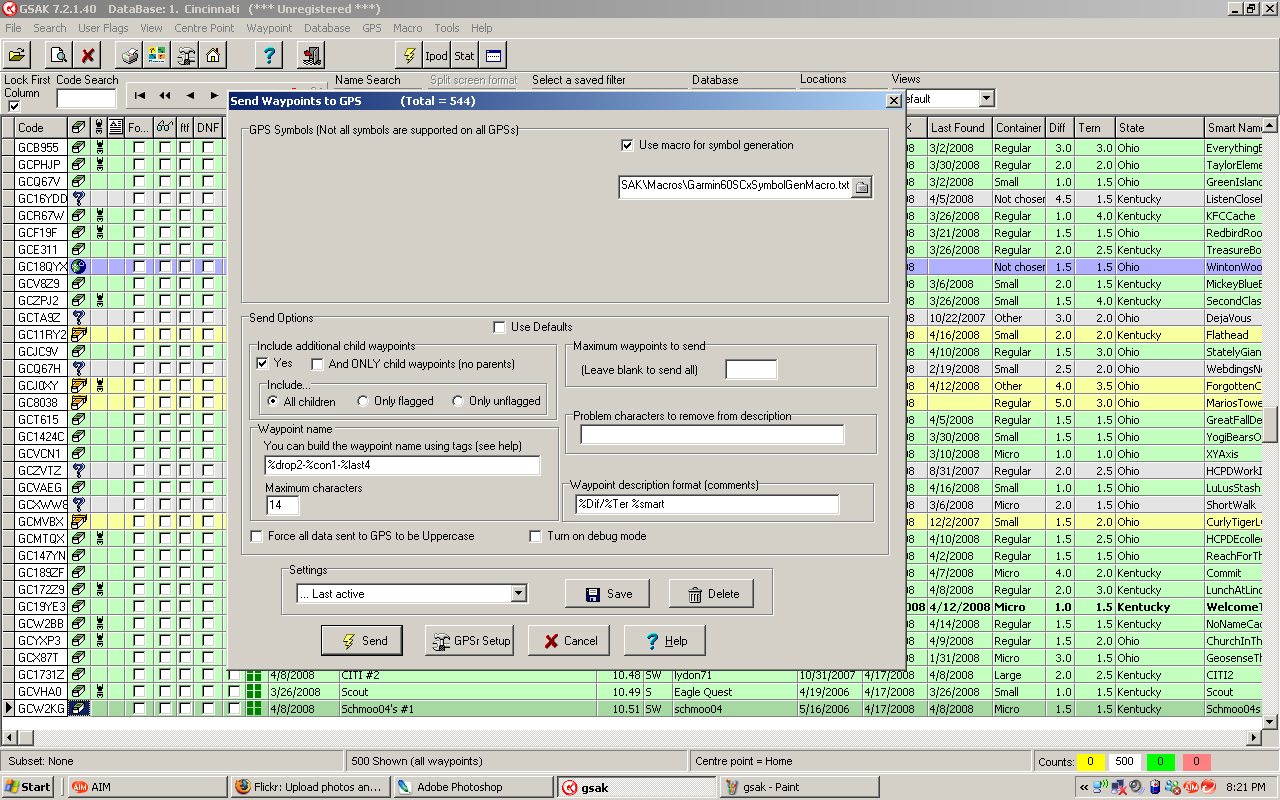 If you note in the left of the two pictures above you can see all the different queries I run. 500 in one area, 300 in another area. Some run when I ask them too, others run daily. The picture on the right shows the region of my "Cincinnati" query.
If you note in the left of the two pictures above you can see all the different queries I run. 500 in one area, 300 in another area. Some run when I ask them too, others run daily. The picture on the right shows the region of my "Cincinnati" query. Anyways...one thing I love is organizing my queries, finds, DNF's, and basically just being able to look up caches if need be out on the road. How do I do this? I use GSAK, Geocaching Swiss Army Knife. (GSAK) is an all-in-one GPX and waypoint managing system. It allows users to quickly download pocket query GPX files from email, load them into m
Anyways...one thing I love is organizing my queries, finds, DNF's, and basically just being able to look up caches if need be out on the road. How do I do this? I use GSAK, Geocaching Swiss Army Knife. (GSAK) is an all-in-one GPX and waypoint managing system. It allows users to quickly download pocket query GPX files from email, load them into m ultiple databases, organize and sort waypoints by distance or location, view target locations on various online maps, and send the waypoints directly to your PDA or GPS receiver. GSAK is a PC only program, however it runs off of GPSBabel which works on PC, Mac, Linux, and several others. GSAK is free to use for 21 days, but after that it's $20 bucks to prevent nagging screens (which I still have). GSAK has lots of cool features plus add-on "macros" that do other features. GSAK doesn't normally come as colored as you see in my picture on the above right. It is usually plain white (see above left), but I've manged to figure out the "highlight" feature that you can find under the "waypoint" tab.
ultiple databases, organize and sort waypoints by distance or location, view target locations on various online maps, and send the waypoints directly to your PDA or GPS receiver. GSAK is a PC only program, however it runs off of GPSBabel which works on PC, Mac, Linux, and several others. GSAK is free to use for 21 days, but after that it's $20 bucks to prevent nagging screens (which I still have). GSAK has lots of cool features plus add-on "macros" that do other features. GSAK doesn't normally come as colored as you see in my picture on the above right. It is usually plain white (see above left), but I've manged to figure out the "highlight" feature that you can find under the "waypoint" tab. Now, this does absolutely nothing for your GPS, and has no real importance whatsoever...but it does make it look a little better, and easier to see what type of cache you are dealing with. As you can see from the image, I have loaded different columns of cache information I find important while I'm browsing: waypoint name, distance, bearing, container type, difficulty, terrain, DNF status, watching status, etc. I typically set my organization by distance from my home.
Now, this does absolutely nothing for your GPS, and has no real importance whatsoever...but it does make it look a little better, and easier to see what type of cache you are dealing with. As you can see from the image, I have loaded different columns of cache information I find important while I'm browsing: waypoint name, distance, bearing, container type, difficulty, terrain, DNF status, watching status, etc. I typically set my organization by distance from my home. One macro that I run often on GSAK is one that generates Ipod notes. This macro sets up the typical cache page in a note format so I can then browse them and read them paperlessly. It loads several most recent logs, the hint if one is provided, and the owner's description.
One macro that I run often on GSAK is one that generates Ipod notes. This macro sets up the typical cache page in a note format so I can then browse them and read them paperlessly. It loads several most recent logs, the hint if one is provided, and the owner's description.Another great feature on GSAK is actually two different things in one: 1) integrating a custom geocaching symbol pack to use as your icons, and 2) setting up a custom name and note section for each cache you load. From here you can download the macro and custom icon pack. so far the icon pack is supposed to work with the 76 series, 60 series, Legend C, Vista C, Quest 2, and may work on etrex models. This icon pack, integrated with GSAK, will save Traditional caches as a traditional icon, multi caches as a multi icon, puz
 zles as the puzzle icon and so on - instead of having tons of treasure boxes and no idea what kind of cache they are. In looking at the image to the side, you can see some interesting code in the "Waypoint name" field and "Waypoint description format" field. These are just special tags used to help me out in the field with extra data that sending a waypoint from the geocaching.com website alone won't provide. See, when you load a cache right from the geocaching page, the waypoint name is the GC#, and the Note is the Waypoint name - that is the only information given. My name on my gps map shows me, %drop2-%con1-%last4. %drop2 provides the GC name without the GC in front, since the GC is always in front of all caches. %con1 provides me with a letter of the cache I'm looking for, R being regular, S being small, L being large, U being unknown and M being a micro. The last one I use in my name is %last4, which gives me a series of letters for the last 4 logs. FFFF means the last 4 logs were all finds, NFFF is a not find then three finds, etc.
zles as the puzzle icon and so on - instead of having tons of treasure boxes and no idea what kind of cache they are. In looking at the image to the side, you can see some interesting code in the "Waypoint name" field and "Waypoint description format" field. These are just special tags used to help me out in the field with extra data that sending a waypoint from the geocaching.com website alone won't provide. See, when you load a cache right from the geocaching page, the waypoint name is the GC#, and the Note is the Waypoint name - that is the only information given. My name on my gps map shows me, %drop2-%con1-%last4. %drop2 provides the GC name without the GC in front, since the GC is always in front of all caches. %con1 provides me with a letter of the cache I'm looking for, R being regular, S being small, L being large, U being unknown and M being a micro. The last one I use in my name is %last4, which gives me a series of letters for the last 4 logs. FFFF means the last 4 logs were all finds, NFFF is a not find then three finds, etc.Inside of the note feature for a cache, I have %Dif/%Ter %smart. This shows me the difficulty/terrain rating followed by a smart name, which is an abbreviated cache name. Here are some screenshots from GPSr.
 The good thing about the symbol pack (I think) is having the smiley faces be your found symbol instead of the open treasure chest. To me, it just makes my GPSr seem more like a geocaching tool.
The good thing about the symbol pack (I think) is having the smiley faces be your found symbol instead of the open treasure chest. To me, it just makes my GPSr seem more like a geocaching tool.You might be wondering..."how do I do all this to MY GPS?" I WANT IT! Everything you need...downloads and instructions, can all be found on this page.


No comments:
Post a Comment